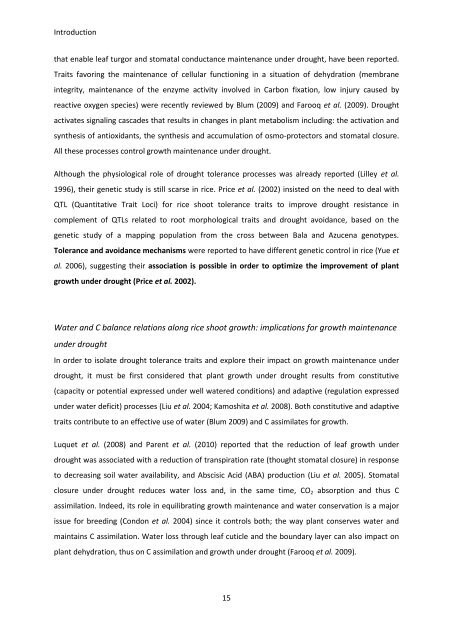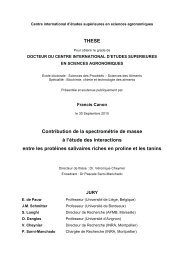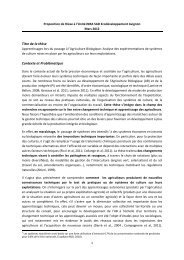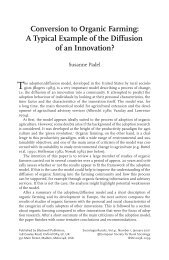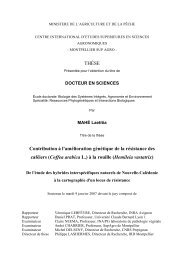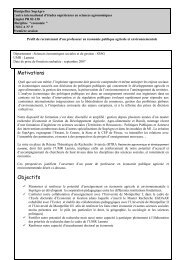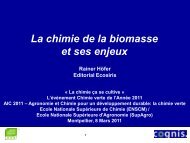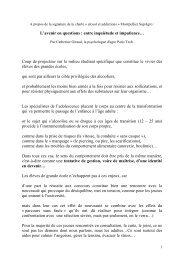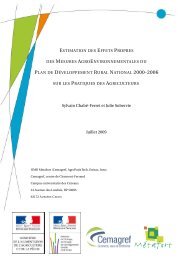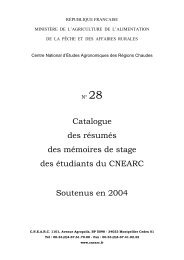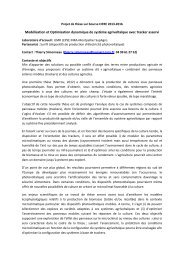Rice (Oryza sativa. L) genetic diversity for early vigor and drought ...
Rice (Oryza sativa. L) genetic diversity for early vigor and drought ...
Rice (Oryza sativa. L) genetic diversity for early vigor and drought ...
- No tags were found...
Create successful ePaper yourself
Turn your PDF publications into a flip-book with our unique Google optimized e-Paper software.
Introductionthat enable leaf turgor <strong>and</strong> stomatal conductance maintenance under <strong>drought</strong>, have been reported.Traits favoring the maintenance of cellular functioning in a situation of dehydration (membraneintegrity, maintenance of the enzyme activity involved in Carbon fixation, low injury caused byreactive oxygen species) were recently reviewed by Blum (2009) <strong>and</strong> Farooq et al. (2009). Droughtactivates signaling cascades that results in changes in plant metabolism including: the activation <strong>and</strong>synthesis of antioxidants, the synthesis <strong>and</strong> accumulation of osmo-protectors <strong>and</strong> stomatal closure.All these processes control growth maintenance under <strong>drought</strong>.Although the physiological role of <strong>drought</strong> tolerance processes was already reported (Lilley et al.1996), their <strong>genetic</strong> study is still scarse in rice. Price et al. (2002) insisted on the need to deal withQTL (Quantitative Trait Loci) <strong>for</strong> rice shoot tolerance traits to improve <strong>drought</strong> resistance incomplement of QTLs related to root morphological traits <strong>and</strong> <strong>drought</strong> avoidance, based on the<strong>genetic</strong> study of a mapping population from the cross between Bala <strong>and</strong> Azucena genotypes.Tolerance <strong>and</strong> avoidance mechanisms were reported to have different <strong>genetic</strong> control in rice (Yue etal. 2006), suggesting their association is possible in order to optimize the improvement of plantgrowth under <strong>drought</strong> (Price et al. 2002).Water <strong>and</strong> C balance relations along rice shoot growth: implications <strong>for</strong> growth maintenanceunder <strong>drought</strong>In order to isolate <strong>drought</strong> tolerance traits <strong>and</strong> explore their impact on growth maintenance under<strong>drought</strong>, it must be first considered that plant growth under <strong>drought</strong> results from constitutive(capacity or potential expressed under well watered conditions) <strong>and</strong> adaptive (regulation expressedunder water deficit) processes (Liu et al. 2004; Kamoshita et al. 2008). Both constitutive <strong>and</strong> adaptivetraits contribute to an effective use of water (Blum 2009) <strong>and</strong> C assimilates <strong>for</strong> growth.Luquet et al. (2008) <strong>and</strong> Parent et al. (2010) reported that the reduction of leaf growth under<strong>drought</strong> was associated with a reduction of transpiration rate (thought stomatal closure) in responseto decreasing soil water availability, <strong>and</strong> Abscisic Acid (ABA) production (Liu et al. 2005). Stomatalclosure under <strong>drought</strong> reduces water loss <strong>and</strong>, in the same time, CO 2 absorption <strong>and</strong> thus Cassimilation. Indeed, its role in equilibrating growth maintenance <strong>and</strong> water conservation is a majorissue <strong>for</strong> breeding (Condon et al. 2004) since it controls both; the way plant conserves water <strong>and</strong>maintains C assimilation. Water loss through leaf cuticle <strong>and</strong> the boundary layer can also impact onplant dehydration, thus on C assimilation <strong>and</strong> growth under <strong>drought</strong> (Farooq et al. 2009).15


